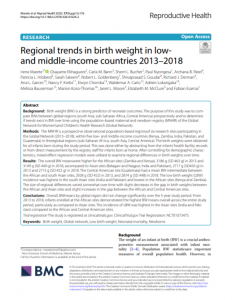
Background
Birth weight (BW) is a strong predictor of neonatal outcomes. The purpose of this study was to compare BWs between global regions (south Asia, sub-Saharan Africa, Central America) prospectively and to determine if trends exist in BW over time using the population-based maternal and newborn registry (MNHR) of the Global Network for Women’s and Children’s Health Research (Global Network).
Methods
The MNHR is a prospective observational population-based registry of six research sites participating in the Global Network (2013–2018), within five low- and middle-income countries (Kenya, Zambia, India, Pakistan, and Guatemala) in three global regions (sub-Saharan Africa, south Asia, Central America). The birth weights were obtained for all infants born during the study period. This was done either by abstracting from the infants’ health facility records or from direct measurement by the registry staff for infants born at home. After controlling for demographic characteristics, mixed-effect regression models were utilized to examine regional differences in birth weights over time.
Results
The overall BW means were higher for the African sites (Zambia and Kenya), 3186 g (SD 463 g) in 2013 and 3149 g (SD 449 g) in 2018, as compared to Asian sites (Belagavi and Nagpur, India and Pakistan), 2717 g (SD450 g) in 2013 and 2713 g (SD 452 g) in 2018. The Central American site (Guatemala) had a mean BW intermediate between the African and south Asian sites, 2928 g (SD 452) in 2013, and 2874 g (SD 448) in 2018. The low birth weight (LBW) incidence was highest in the south Asian sites (India and Pakistan) and lowest in the African sites (Kenya and Zambia). The size of regional differences varied somewhat over time with slight decreases in the gap in birth weights between the African and Asian sites and slight increases in the gap between the African and Central American sites.